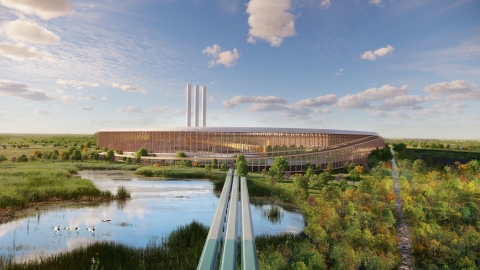Bjarke Ingels Group and The Metals Company Design a New Generation of Offshore and Onshore Assets to Produce Critical EV Battery Metals From Seafloor Rocks
BIG-Bjarke Ingels Group, the acclaimed global architecture firm whose groundbreaking work incorporates innovations in architecture, has collaborated with The Metals Company, a developer of lower-impact battery metals from seafloor polymetallic nodules, to remake conventional metal production for the 21st century as society embarks on the transition to a net-zero-carbon future. The Metals Company announced in March that it will merge with Sustainable Opportunities Acquisition Corporation (NYSE:SOAC) to go public on the NASDAQ in Q2 2021.

Zero-solid-waste metallurgical plant (Photo: Business Wire)
The Metals Company’s challenge with BIG was to bring innovative, whole-systems design to the industrial components needed to supply the world with critical battery metals from polymetallic nodules—fist-sized rocks containing battery-grade nickel, cobalt, copper and manganese—while reimagining the nexus of industry and community. BIG delivered an integrated suite of assets that work together to lift nodules off the seafloor and up to a purpose-built production vessel, transfer them to a hydrodynamic shuttle carrier, and onward to a metallurgical plant designed to transform an urban port site into a battery materials innovation and community hub, set within a regenerative coastal landscape.
“To collect the nodules, we have designed a light-touch, robotic collector vehicle that aims a jet of seawater across the tops of the rocks to gently pry them from the sediment. Part of our design for future collectors includes a buoyant, hydrodynamic shell with an extended lip to minimize seafloor compaction and reduce and redirect the dust plume kicked up during nodule collection,” said Daniel Sundlin, partner at BIG and partner in charge of the collaboration with The Metals Company.
The Metals Company’s first-generation collector vehicle has been engineered and is currently being built by Allseas in the Netherlands to be deployed for testing early next year.
Nodules are transported through a flexible hose at the top of the collector vehicle to a rigid riser pipe where they are lifted on compressed air bubbles ~4 km up to the surface production vessel, a 216-meter-long ship that runs on carbon-neutral electrofuels, with a sunken deck that is covered with photovoltaic solar panels. The streamlined design of the production vessel is driven by functionality. Equipment for nodule collection is strategically packed in the hull to minimize the size of the vessel and maximize operational efficiency. At scale, each production vessel would operate multiple collectors with additional maintenance capacity provided by a support vessel with a ‘moon pool’ for deploying and retrieving collector vehicles.
While The Metals Company’s first production vessel is a deep-water drillship repurposed by Allseas to enable pilot nodule collection, BIG’s next generation vessel design is central to The Metals Company’s plans to scale to a fleet of 10 production vessels, enabling the provision of over 40 million tons of battery metals by 2050, enough to produce 280 million electric vehicles (EVs)—a quarter of the global passenger car fleet.
At full-scale operations, nodules will be transferred from the production vessels to shuttle carriers, whose X-bow design was chosen by BIG to deliver hyper-efficient, hydrodynamic ships to further assist The Metals Company in lowering the carbon footprint of its battery metals. Once at port, the nodules are offloaded onto a conveyor and into a portside processing plant—designed by BIG as a sustainable, performative and social campus in a regenerative landscape that turns conventional metallurgy on its head.
“Deep-water ports around the world are often degraded ecosystems unwelcoming to local communities. We asked BIG to reimagine what a metals-processing facility could be, to have it integrate with—even remediate—the urban coastal environment,” said The Metals Company Chairman and CEO, Gerard Barron. “The result is a breathtaking innovation complex that will transform an industrial port into a community-based hub for the electric vehicle revolution.”
“The global energy system needs to undergo its most profound change in centuries to realize a world run exclusively on renewable sources. If the ongoing research and studies conclude that harvesting minerals from the seabed can be done in an environmentally and socially responsible way, we will not only be able to accelerate the green transition but give form to an entirely new industry that will create a sustainable circular metals economy for future generations,” said Founder and Creative Director in BIG-Bjarke Ingels Group, Bjarke Ingels.
BIG, well known for creating a ski slope on a waste-to-energy plant in Copenhagen, designed The Metals Company’s circular, zero-solid-waste metallurgical plant to contain pyrometallurgical processing and hydrometallurgical refining steps, stockpiles, and product storage alongside offices, visitor-centric experiences, and an innovation center to tie products into the EV supply chain. The company envisions multiple facilities spread across three continents and a number of brownfield sites are currently under consideration. These plants would in time be retooled to recycle battery cathodes at end-of-life, closing the loop on the battery metals supply chain.
“The world is characterized by a mindset that divides the world into front of house and back of house. The front of house is carefully designed in the form of beautiful facades and lush parks, leaving the back of house as purely utilitarian and logistical leftovers in the form of parking lots and warehouses. With The Metals Company, we are designing a human made ecosystem channeling the flow of resources with the care and attention conventionally reserved for the front of house. A next-generation materials industry,” said Bjarke Ingels.
“We’re remaking how society gets, uses and ultimately re-uses the base metals which form the foundation of the clean energy economy,” said Barron. “BIG has delivered these radical, low-impact designs to help us remake an industry. Now the exciting question is, which port will we transform first?”
ABOUT THE METALS COMPANY
The Metals Company is a Canadian developer of lower-impact battery metals from seafloor polymetallic nodules, on a dual mission: (1) supply metals for the clean energy transition with the least possible negative environmental and social impact and (2) accelerate the transition to a circular metal economy. The company through its subsidiaries holds exploration and commercial rights to three polymetallic nodule contract areas in the Clarion Clipperton Zone of the Pacific Ocean regulated by the International Seabed Authority and sponsored by the governments of Nauru, Kiribati and the Kingdom of Tonga. In March, The Metals Company announced that it had entered into a business combination agreement with Sustainable Opportunities Acquisition Corporation (SOAC) to accelerate project development and take it public on NASDAQ as ‘The Metals Company’. More information is available at https://www.metals.co/.
ABOUT BJARKE INGELS GROUP
BIG-Bjarke Ingels Group is a Copenhagen, New York, London, Shenzhen, and Barcelona based group of architects, designers, urbanists, landscape professionals, interior and product designers, researchers and inventors. The office is currently involved in projects throughout Europe, America, Asia and the Middle East. BIG’s architecture emerges out of a careful analysis of how contemporary life constantly evolves and changes. By hitting the fertile overlap between pragmatic and utopia, we architects once again find the freedom to change the surface of our planet, to better fit contemporary life forms.
Find more information at www.big.dk.
View source version on businesswire.com: https://www.businesswire.com/news/home/20210512005310/en/







